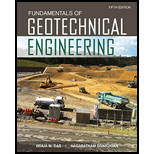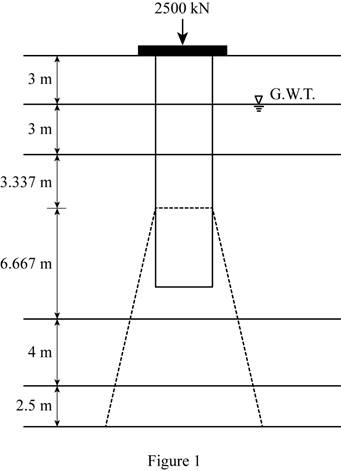
Concept explainers
Find the consolidation settlement of the group.
Answer to Problem 18.25P
The consolidation settlement of the group is
Explanation of Solution
Given information:
The total load
The length
The length
The length
The unit weight
The saturated unit weight
The initial void ratio
The coefficient of consolidation
The saturated unit weight
The initial void ratio
The coefficient of consolidation
The saturated unit weight
The initial void ratio
The coefficient of consolidation
The saturated unit weight
The initial void ratio
The coefficient of consolidation
Calculation:
Show the pressure diagram as in Figure 1.

Determine the total length L of pile using the formula.
Substitute 3 m for
The load starts transmitting to the soil at the pile depth of
Determine the depth at which the load on the group pile
Here, L is the depth of normally consolidated clay layer 1.
Substitute 10 m for L.
Thus, the settlement starts in NCC layer 1.
Determine the stress
Here,
Take the unit weight of water as
Substitute
Determine the stress
Here,
Substitute
Determine the stress
Here,
Substitute
Calculate the stress
Here,
Substitute 2,500 kN for
Calculate the stress
Substitute 2,500 kN for
Calculate the stress
Substitute 2,500 kN for
Determine the value of
Substitute
Determine the value of
Substitute
Determine the value of
Substitute
Determine the consolidated settlement
Here,
Substitute 0.30 for
Determine the consolidated settlement
Here,
Substitute 0.35 for
Determine the consolidated settlement
Here,
Substitute 0.26 for
Determine the total
Substitute 0.186 m for
Therefore, the consolidated settlement of the group pile is
Want to see more full solutions like this?
Chapter 18 Solutions
Fundamentals of Geotechnical Engineering (MindTap Course List)
- A simply supported rectangular RC beam is to carry a uniform factored dead load of 1.2 kip/ftand a concentrated factored live load of 16 kip at mid-span. The beam self-weight is not includedin these loads. The concrete weighs 135 pcf. The span length is 25 ft. Please find the smallestsection allowed by ACI and design accordingly. Use f c’ = 5,000 psi, f y = 75,000 psi. Theexposure is interior with no weather exposure.a. Assume an arbitrary self-weight/ft of the beam.b. Find the maximum factored bending moment in the beam.c. Set up the moment equation and solve for the beam section.d. Revise the assumption if needed.Hint: The beam section (b and h) and steel reinforcement are inversely proportional. The smallestallowable beam section will be for the largest allowable steel ration (ρmax), and vice versa. Sincethe steel ratio is fixed, two remaining variables (b, d) need to be found from the moment equations.Then, bd2 term can be solved to get an acceptable b and d combination.arrow_forwardFind: ftop and fbottom of (initial stage, construction phase, final stage)arrow_forward+150+ Assignment SW+ SLAB SDL = 250 150 - 3.3 kPa укра LL = 3 kPa 3 ୪ 8c = 23.6 kN/m² P = 3000 KN loss, = 9% Coss = 20% LBEAM = 9m COMPUTE AND DRAW THE STESS DIAGRAM (TRIBUTARY WIDTH= 600m 350mm FIND: f TOP & BOTTOM fe = 35Mpa 100mm f'c = 42.5 MPa 218 5m) EC = 4700 √ fc (MPa) (Initial, Const. phase, final stage)arrow_forward
- Design a cantilevered rectangular RC beam subjected to a maximum factored load bending moment, M u = 260 kip-ft. The clear height requirements for the building limits the total beam depth to 22 in. Determine the beam width and the steel design. Use f c’ = 6,000 psi, f y = 40,000 psi. The grade beam is cast against earth and permanently in contact with soil. a. Assume an initial steel ratio or beam width. b. Set up the bending design equation. c. Solve for either the steel ratio or the beam width. d. Design needed steel. 2 Hint: Knowing “h”, one can estimate the “d” value. So, two remaining variables can be estimated. There are many acceptable solutions. You can either assume a steel ration and solve for width “b”, or assume a beam width “b” and solve for the steel ratio. Remember that a good beam aspect ratio (d/b) is approximately 2.0arrow_forwardA 15 in. x 26 in. rectangular RC beam (shown in figure below) supports a service uniform dead load of 1.3 kip/ft and a service uniform live load of 1.6 kip/ft. The dead load includes the beam’s self-weight. Design the reinforcement required for maximum moments and show the design in sketches. Use f c ’ = 4,000 psi and f y = 60,000 psi. The beam is used in an open parking garage and is exposed to weather. a. Find factored maximum bending moments. b. Design for max. negative moment. c. Design for max. positive moment. Hint: Assume an initial beam shape (b, d), then solve for the needed reinforcements at the maximum negative and positive factored bending moments. This is like the class example.arrow_forwardA simply supported rectangular RC beam is to carry a uniform factored dead load of 1.2 kip/ftand a concentrated factored live load of 16 kip at mid-span. The beam self-weight is not includedin these loads. The concrete weighs 135 pcf. The span length is 25 ft. Please find the smallestsection allowed by ACI and design accordingly. Use f c’ = 5,000 psi, f y = 75,000 psi. Theexposure is interior with no weather exposure.a. Assume an arbitrary self-weight/ft of the beam.b. Find the maximum factored bending moment in the beam.c. Set up the moment equation and solve for the beam section.d. Revise the assumption if neededarrow_forward
- 3k a 5 I IKLF d 25 5' S' E=29000ksi I = 400 in 4 Ex = ? Q = ?arrow_forwardA simply supported rectangular RC beam is to carry a uniform factored dead load of 1.2 kip/ft and a concentrated factored live load of 16 kip at mid-span. The beam self-weight is not included in these loads. The concrete weighs 135 pcf. The span length is 25 ft. Please find the smallest section allowed by ACI and design accordingly. Use f c’ = 5,000 psi, f y = 75,000 psi. The exposure is interior with no weather exposure. a. Assume an arbitrary self-weight/ft of the beam. b. Find the maximum factored bending moment in the beam. c. Set up the moment equation and solve for the beam section. d. Revise the assumption if neededarrow_forwardIdeal gas Problems 3-1 The molecular weight of carbon dioxide, CO2, is 44. In an experiment the value y for CO2 was found to be 1.3. Assuming that CO2 is a perfect gas, calculate the gas constant, R, and the specific heats at constant pressure and constant volume, Cp, Cv (0.189 kJ/kg.K; 0.63kJ/kg.K; 0.819kJ/kg.K) 3-2 Oxygen, O2, at 200 bar is to be stored in a steel vessel at 20°C the capacity of the vessel is 0.04m³. Assuming that O₂ is a perfect gas, calculate the mass of oxygen that can be stored in the vessel. The vessel is protected against excessive pressure by a fusible plug which will melt if the temperature rises too high. At what temperature must the plug melt to limit the pressure in the vessel to 240bar? The molecular weight of oxygen is 32 (10.5 kg; 78.6°C) 3-3 A quantity of a certain perfect gas is compressed from an initial state of 0.085m³, 1 bar to a final state of 0.034m³, 3.9 bar. The specific heats at constant volume are 0.724 kJ/kg.K, and the specific heats at…arrow_forward
- A trapezoidal combined footing 5.5 m long is to supporttwo 400 mm square columns 5 meters apart. The center ofthe columns are both 0.25m away from property lines. Theleft column carries 675 kN while the right column 825 kN.The allowable soil pressure is 126 kPa. Assume footing is0.5m thick with soil backfill 0.7m thick. Weight of concreteis 23.6 kN/m3 and of soil is 20.4 kN/m3. 1. Determine the required footing area.2. Find the width of the smaller end of the footing.3. Calculate the width of the larger end of the footing.Ans:15.01m2, 2m, 3.5m please show the solution. Answer is providedarrow_forwardH.W: Evaluate the integral 1. 1 1 }} 0 y x²exy dxdy 2. 1 ܐy 2 dxdyarrow_forwardGiven the following end areas for cut & fill, complete the eart calculation using a shrinkage of 10%. Then draw the M.H.D. and the longitudinal pro of the earthworks & find the following: a) Limit of Economic Haul (L.E.H.). b) Freehaul volume (F.H.V.). c) Overhaul volume (O.H.V.). d) Waste volume. e) Borrow volume. f) Total cost of the earthworks. Given that: -Cost of overhaul = 30 ID/m².station. -Cost of borrow-120 ID/m³. - Cost of freehaul - 70 ID/m². -Freehaul Distance (F.H.D.)- 200m-2 stations. Areas (m²) Station Volumes (m) Cut Fill Cut+ Fill- 0 10 Corrected Fill- 1100 1 12 1300 2 14 1500 3 146 1500 14 350 550 250 275 10 5 16 96 1300 1430 6 1500 1650 14 7 1300 1430 12 S . 1000 1100 8 9 300 200 220 12 10 1400 16 11arrow_forward
 Fundamentals of Geotechnical Engineering (MindTap...Civil EngineeringISBN:9781305635180Author:Braja M. Das, Nagaratnam SivakuganPublisher:Cengage Learning
Fundamentals of Geotechnical Engineering (MindTap...Civil EngineeringISBN:9781305635180Author:Braja M. Das, Nagaratnam SivakuganPublisher:Cengage Learning Principles of Foundation Engineering (MindTap Cou...Civil EngineeringISBN:9781337705028Author:Braja M. Das, Nagaratnam SivakuganPublisher:Cengage Learning
Principles of Foundation Engineering (MindTap Cou...Civil EngineeringISBN:9781337705028Author:Braja M. Das, Nagaratnam SivakuganPublisher:Cengage Learning Principles of Foundation Engineering (MindTap Cou...Civil EngineeringISBN:9781305081550Author:Braja M. DasPublisher:Cengage Learning
Principles of Foundation Engineering (MindTap Cou...Civil EngineeringISBN:9781305081550Author:Braja M. DasPublisher:Cengage Learning Principles of Geotechnical Engineering (MindTap C...Civil EngineeringISBN:9781305970939Author:Braja M. Das, Khaled SobhanPublisher:Cengage Learning
Principles of Geotechnical Engineering (MindTap C...Civil EngineeringISBN:9781305970939Author:Braja M. Das, Khaled SobhanPublisher:Cengage Learning



